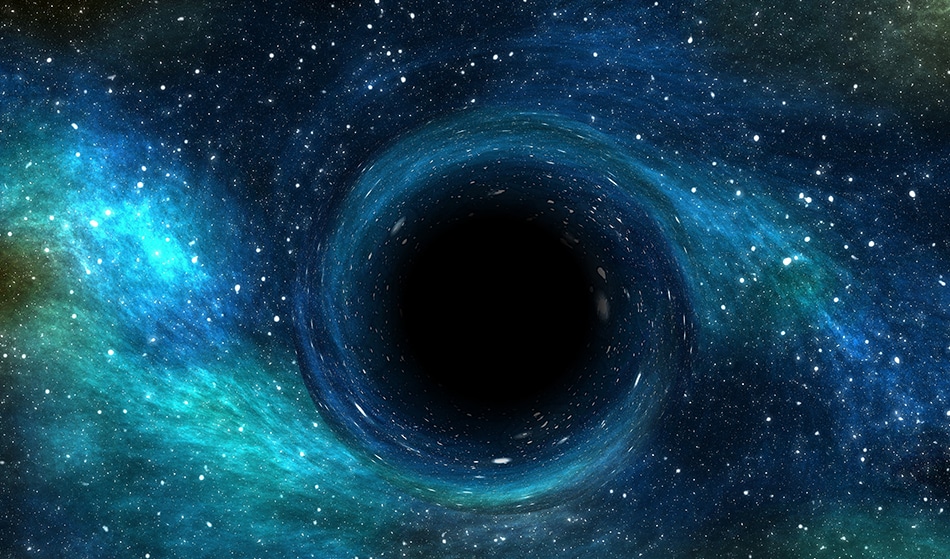 vchal/shutterstock
vchal/shutterstock
Black holes are well known for consuming everything in space around them due to their huge gravitational pull, but we know less about their 'burps'. Now a double burping black hole has been discovered.
The Hubble and Chandra space telescopes caught the black hole in the action of burping. It occurred after the black hole had consumed hot cosmic gas, causing the release of energy back into space in the form of a space belch.
The images captured of the black hole over 800 million light-years away, not only showed a burp but a second that occured 100,000 years earlier. The belch, consisting of a stream of high-energy particles was fired out from the black hole both times.
The events were revealed at the 231st American Astronomical Society meeting in Washington DC where Julie Comerford, from the University of Colorado, stated: "Black holes are voracious eaters, but it turns out they don't have very good table manners. There are a lot of examples of black holes with single burps emanating out, but we discovered a galaxy with a supermassive black hole that has not one but two burps."
This particular supermassive black hole, which is potentially billions of times the size of our sun, is at the centre of a galaxy called SDSSJ1354+1327, or J1354 for short. X-ray emissions were picked up from this galaxy by the Chandra telescope. This provided the information about exactly where the centre of that galaxy is location and therefore where the supermassive black hole is.
Using that data, the Hubble space telescope could be pointed at the source of the x-rays. This revealed a blue-green gas that escaped from the centre of the black hole, representing the aftermath of an earlier burp. In the cone of that gas, the electrons were found to have been stripped away from atoms leading to the conclusion that it was caused by a burst of radiation from the vicinity of the black hole.
It had then expanded a massive 30,000 light years away from the black hole itself. But a loop was found in the image that suggests a new belch had also emerged from the cosmic sinkhole.
Dr Comerford concluded that the black hole was going through a cycle of feasting on cosmic gas, burping then napping, before starting again. The result was like a light turning on and off over the span of 100,000 years. This sounds like a long time to us but cosmically speaking that is very fast indeed.
The optical data indicate that, in the past, the supermassive black hole appears to have consumed, or accreted, large amounts of gas while blasting off an outflow of high-energy particles. The outflow eventually switched off then turned back on about 100,000 years later. This is strong evidence that accreting black holes can switch their power output off and on again over timescales that are short compared to the 13.8 billion-year age of the Universe.
Chandra X-ray Observatory
Researchers also used data from the W.M. Keck Observatory atop Mauna Kea, Hawaii and the Apache Point Observatory (APO) in New Mexico for this finding.
Until now the idea that black holes light up and go dark as they experience these cycles was simply a theory. Now it has been observed. So why did it happen twice?
Researchers theorised that the black hole consumed two different “meals” of cosmic gas. This is likely the result of the galaxy colliding with another galaxy nearby. "There's a stream of stars and gas connecting these two galaxies. That collision led gas to stream towards the supermassive black hole and feed it two separate meals that led to these two separate burps," said Dr Comerford.
This new burp is actually moving like a shockwave that is coming out very fast. I thought of an analogy for this and I was debating whether to use it or whether it's a little too gross... imagine someone eating dinner at their kitchen table and they're eating and burping, eating and burping. You walk in the room and you notice there's an old burp still hanging in the air from the appetiser course. Meanwhile, they're eating the main course and they let out a new burp that's rocking the kitchen table.
Julie Comerford
Disclaimer: The views expressed here are those of the author expressed in their private capacity and do not necessarily represent the views of AZoM.com Limited T/A AZoNetwork the owner and operator of this website. This disclaimer forms part of the Terms and conditions of use of this website.